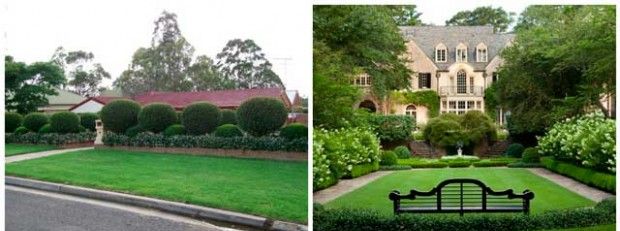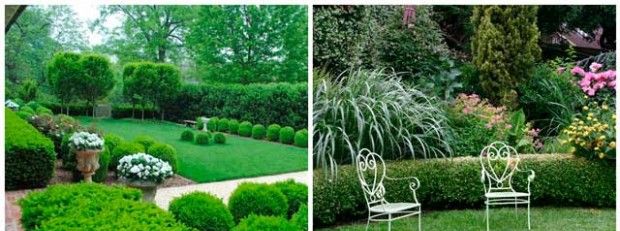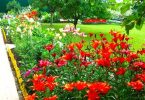A hedge is an alternative to a conventional fence. It serves as a fence and framing of the local area, a popular component of landscape design. Blending organically into the surrounding space, a hedge solves a lot of practical and decorative tasks, it becomes an excellent background for other green spaces.
Types of hedges
The classification of hedges is based on the characteristics of the selected plants: their shape, height, width, characteristic biological characteristics.
By form green fences are divided into free growing (unshaped) and sheared (molded).
- Free growing take up much more space, but, unlike molded ones, do not require anxious care and constant attention. Pruning of abundantly flowering plantations is carried out only once a year.
- Shorn, on the contrary, regular care is needed. Trimming allows you to preserve the aesthetics of the enclosing «walls», give it a clear geometric shape. After several years, such hedges become completely obscure and unpretentious..
Cutting fences of this type is selected taking into account the preferences of the owner and the types of plants used. A hedge can be rectangular, trapezoidal, triangular or rounded. Based on them, you can experiment and create various landscape compositions..

Hedges are classified and in height. Three types are distinguished here:
- curbs (up to a meter in height);
- live fences (from one meter to two);
- living walls (the height exceeds two meters).
Depending on on the complexity of the device, hedges come in one, two or three rows, consisting of homogeneous or heterogeneous plants.
Two- and three-row planting arrangement involves the placement of plants in several layers of different heights. This combination allows you to achieve a spectacular appearance, high-quality protection from prying eyes..
There are also the following types of hedges:
- tapestry with natural weave – planting in one row with branches crossing when weaving;
- tapestry with artificial weave – plantings in which adjoining shoots are spliced artificially;
- portable, providing a temporary protective or decorative function;
- curly, representing a kind of flight of fantasy landscape design. With the help of topiary art, hedges are designed in the form of a variety of images, figures, forms, and sometimes even architectural monograms.
The specifics of using hedges
A green fence serves a number of purposes. The main ones are:
- registration and zoning of the site;
- providing protection from the external environment, the influence of negative factors (noise, dust, wind, exhaust gases, etc.);
- fencing off unsightly, unpresentable outbuildings.
It is more rational to use free-growing hedges in areas the size of which allows them to fit. Shaped fencing – ideal for compact spaces.
Borders are often used as a decorative element, highlighting paths to the house or decorating flower beds and flower beds. Living walls are planted along the boundaries of the site and provide high protection from wind and noise.
Fences of two or three rows meet both protective and architectural and aesthetic requirements. Using plants of different species, you can create a semblance of a tapestry – in the landscape design of the local area, the composition will look noble and aristocratic.
Plants suitable for hedges
When choosing plants for a hedge, you first need to decide on its height.
For curbs red-leaved rose hips, golden currants, columnar juniper, purple barberry are suitable. Among the flowering species, one can distinguish the Wangutta spirea, mock orange, Amur lilac, heather, tree hydrangea and a rose..
For hedges medium height choose alpine currant, common barberry, hawthorn, cotoneaster, Ginnal maple, Canadian spruce, western thuja.
Living wall «erect» from Lawson cypress, common and prickly spruce, Chinese and columnar juniper, western thuja, berry yew.
Free growing a green hedge is formed from smooth irgi, white dogwood, Thunberg barberry, Japanese kerria, Tatar honeysuckle, black elderberry, rose, viburnum.
Multi-row hedges look great with variegated plants with contrasting colors, such as red-leaved beech, boxwood, light green hornbeams and vines.
Tapestry with naturally and artificially intertwined shoots, they are built from willow, pear, hawthorn, elm and buckthorn.
Hedges: planting and care
Before planting, you need to understand the features of the selected plants. The composition of the soil, the growth rate, the characteristic features of the crown, aesthetic compatibility – if all the nuances are not observed correctly, a disastrous result can come out.
Planting works are organized from April to June – for species with an open root system, in August – for conifers, and from August to October – for deciduous.
Plants are planted in pre-prepared trenches. For a hedge in one row, the width of the trench should not be less than 50 cm, for two rows – 90 cm, and for each subsequent row, the increase is 40 cm.The depth is standard – 50-60 cm.
Soil mix, consisting of a fertile layer, compost, mineral fertilizers, are poured into the ditch, while taking into account the further subsidence of the substrate. Pegs are installed, the rope is pulled, necessary to ensure an even landing. After the preparatory work, the pegs are removed and planting begins.

Upon completion of planting work, watering with an admixture of root formation stimulants, soil mulching with sawdust or peat.
Care behind hedges is reduced to regular watering, loosening, weeding, feeding and cutting. Such activities are aimed at developing new shoots, enhancing plant growth and maintaining its attractive appearance..




















